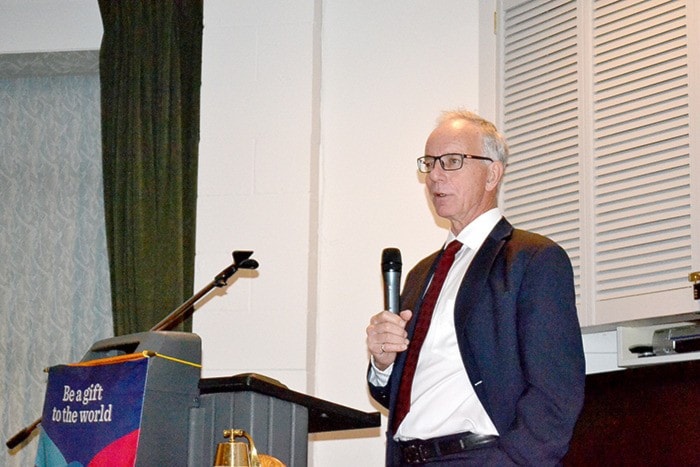B.C. oil refinery proponent David Black says his $22-billion proposal won’t die with the apparently thwarted Northern Gateway pipeline – he aims to bring oil sands bitumen across northern B.C. by train instead.
The Victoria businessman, who is majority owner of Black Press and this newspaper, spoke Wednesday at a Rotary Club meeting in South Surrey.
Black’s Kitimat Clean proposal calls for a refinery between Terrace and Kitimat that would process bitumen into gasoline, diesel and other refined fuels for Asian markets.
He said the federal Liberal government’s move to formally ban crude oil tankers from B.C.’s north coast means the Northern Gateway pipeline plan is “pretty much dead” but that shouldn’t block tanker exports of refined fuel, which would be less damaging than a spill of crude or bitumen at sea.
Black said his plan to carry oil by rail will be far safer than the crude oil trains that have been vulnerable to fiery disasters elsewhere.
He said he’s in talks with CN Rail to load rail cars with undiluted bitumen, which would be much thicker – virtually solid – compared to the diluted bitumen that moves through pipelines or the light oil that’s often carried by train.
The bitumen would be heated at the beginning and end of each rail trip to make it flow for loading and unloading from tanker cars. Black argues it would be unlikely to leak or burn if a train derailed.
“It’s safer and way easier,” he said, estimating six trains a day would run every four hours.
Black continues to pursue environmental approvals, and believes that with green lights from regulators and first nations, oil shippers and financiers will come on board.
But his is not the only such proposal.
Pacific Future Energy, led by a Mexican conglomerate, initially tried to buy Black out and has since proposed a similar refinery with the same technology. Its backers include SNC Lavalin and prominent aboriginal advisors.
Pacific Future initially proposed a site in Prince Rupert but Black said that firm is trying to strike a deal with the Kitselas band for the same site Kitimat Clean had chosen.
There are other potential sites with different first nations, he said, but they’re less suitable.
Black also criticized the provincial government’s focus on liquefied natural gas projects.
He said his refinery would generate more permanent jobs and taxes for governments than even an optimistic number of LNG plants.
“Government really dove at this,” he said, adding the province “rolled over” in guaranteeing generous tax treatment to get the industry on board, leaving little future revenue to government.
Too many LNG plants are already being built in Australia and the U.S., he said, while Japan’s shift back towards nuclear power will cut demand.
“I just don’t think there’s much chance,” Black said. “The LNG dream is now fading.”
Black is not concerned that low oil prices will also doom his refinery dream.
He said he believes low prices as well as the U.S. rejection of the Keystone XL pipeline to the U.S. Gulf Coast will make his option for reaching lucrative Pacific markets increasingly attractive to oil firms grappling with narrowing margins, particularly in Alberta’s oil sands.
Black maintains a refinery can’t be built in Alberta itself because of opposition from multinational oil firms that own Texas refineries, and because the large prefabricated modules that can be assembled on the B.C. coast can’t be hauled inland.
His proposal would use an unusual technology – adding $5 billion to the costs – that slashes the carbon emissions to less than one third of a conventional refinery.
Black argues the “greenest refinery in the world” would largely offset the higher emissions of oil sands bitumen and forge a political solution for Canada’s energy policy makers.
“It cleans the whole industry up,” Black said. “We’re not in the dirty oil business any more. We get huge value add. And it takes away the issue of a heavy oil spill at sea.”
Bitumen oil, he said, is a fairly solid substance that requires diluent material to pump it in a pipeline.
In a rail car it just has to be heated to be poured in and then re-heated at the other end to enter the refinery.
For the journey the material is so solid that he said in the case of any derailment of the train there’s a good chance the bitumen might not even leak out of the rail car.
“As it cools a few degrees it sets like wax,” he said. “That’s what you’re shipping. If there’s a derailment it’s not going to run out of the car.”
Oil by rail was not always in his plans though.
“I lived in Williams Lake for 10 years beside the rail line and I knew how many derailments there were continually. It’s just an ongoing fact of life in the rail business,” he said. “So I thought this could be a disaster.”
But he said consultations have changed his mind.
He said the bitumen has to be heated to 60C to be poured in to rail cars.
When it arrives at the refinery steam coils built in to the cars are connected to live steam to loosen it again allowing it to be poured out.
“It could go by pipe too, but rail, in many ways, is simpler.”
As for the overall game plan for the refinery, he says he had some questions regarding the site to work out before he could submit his environmental description with the government, but said that description, the first step in an environmental review, would go in before Christmas.
It’s a two-year process to get permits, and he said he’ll be seeking financing during that time too.
Once financing and the review is done he said it will take up to six years to construct the facility.
At those estimates the refinery could potentially be running by 2023.
